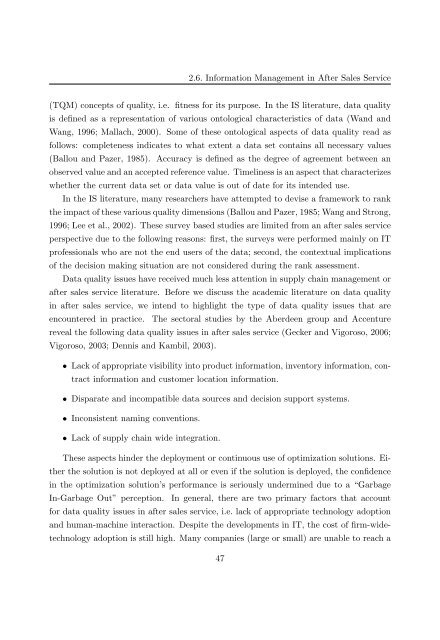Customer Information Driven After Sales Service ... - RePub
Customer Information Driven After Sales Service ... - RePub
Customer Information Driven After Sales Service ... - RePub
Create successful ePaper yourself
Turn your PDF publications into a flip-book with our unique Google optimized e-Paper software.
2.6. <strong>Information</strong> Management in <strong>After</strong> <strong>Sales</strong> <strong>Service</strong><br />
(TQM) concepts of quality, i.e. fitness for its purpose. In the IS literature, data quality<br />
is defined as a representation of various ontological characteristics of data (Wand and<br />
Wang, 1996; Mallach, 2000). Some of these ontological aspects of data quality read as<br />
follows: completeness indicates to what extent a data set contains all necessary values<br />
(Ballou and Pazer, 1985). Accuracy is defined as the degree of agreement between an<br />
observed value and an accepted reference value. Timeliness is an aspect that characterizes<br />
whether the current data set or data value is out of date for its intended use.<br />
In the IS literature, many researchers have attempted to devise a framework to rank<br />
the impact of these various quality dimensions (Ballou and Pazer, 1985; Wang and Strong,<br />
1996; Lee et al., 2002). These survey based studies are limited from an after sales service<br />
perspective due to the following reasons: first, the surveys were performed mainly on IT<br />
professionals who are not the end users of the data; second, the contextual implications<br />
of the decision making situation are not considered during the rank assessment.<br />
Data quality issues have received much less attention in supply chain management or<br />
after sales service literature. Before we discuss the academic literature on data quality<br />
in after sales service, we intend to highlight the type of data quality issues that are<br />
encountered in practice. The sectoral studies by the Aberdeen group and Accenture<br />
reveal the following data quality issues in after sales service (Gecker and Vigoroso, 2006;<br />
Vigoroso, 2003; Dennis and Kambil, 2003).<br />
• Lack of appropriate visibility into product information, inventory information, contract<br />
information and customer location information.<br />
• Disparate and incompatible data sources and decision support systems.<br />
• Inconsistent naming conventions.<br />
• Lack of supply chain wide integration.<br />
These aspects hinder the deployment or continuous use of optimization solutions. Either<br />
the solution is not deployed at all or even if the solution is deployed, the confidence<br />
in the optimization solution’s performance is seriously undermined due to a “Garbage<br />
In-Garbage Out” perception. In general, there are two primary factors that account<br />
for data quality issues in after sales service, i.e. lack of appropriate technology adoption<br />
and human-machine interaction. Despite the developments in IT, the cost of firm-widetechnology<br />
adoption is still high. Many companies (large or small) are unable to reach a<br />
47

















